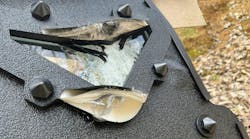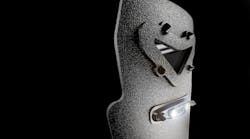Innovation in ballistic shield products can be steadfast. Any changes need to be tested, redesigned, tested again, certified and adaptable. Officers are putting their lives behind the product; that trust does not come lightly. Ergonomics of the handlebar can change from product line to product line, manufacturer to manufacturer. We’ve seen the integration (or removal) of a viewport as well as its size and shape. Even today, law enforcement agencies have a plethora of options for the shape and size of the shield itself. Officers can even get one that folds up in a small package the size of a briefcase.
One of the top issues: weight reduction. It’s no surprise that some manufacturers tried out a few clever ideas to address this. For one, Advanced Accuracy Solutions developed The Reaper Shield Support system. This was a load-bearing exoskeleton providing the wearer, as their announcement describes, “the ability to deliver dominating firepower while safely positioned behind a highly maneuverable NIJ Level IV ballistic shield.”
Other solutions focus more on the shield itself—what it’s made from and how it’s manufactured. Aside from making the entire shield smaller, how would one go about reducing the weight while adhering to the same ballistic protection standards and providing the same features as before? One example is the X Series of ballistic shields from Protech Tactical, a part of The Safariland Group.
Spectra: Quick Facts
· Pound for pound it's 15 times stronger than steel, yet light enough to float
· Spectra-based fishing lines are 4 times stronger than nylon
· It's 30 to 40% stronger than aramid fiber
Initially debuted at the 2018 SHOT Show, the X Series uses Honeywell’s Spectra-based composite material aptly named SpectraShield (the brand name Honeywell uses for their armor ballistic fabrics). Using SpectraShield allowed Safariland’s designers to accomplish an impressive feat: completely removing the bolts to install the viewport. Along with being an overall lighter material, this drops 20 percent of the shield’s weight (roughly 3 pounds on most models). That’s 8 bolts down to zero and 8 drilled holes in the ballistic protection to none.
They’re not reinventing the wheel though, merely making that wheel stronger and lighter. Todd Mackler, vice president of armor for Safariland, explains that the X Series isn’t exactly a brand new shield line but alternative versions of previous models. “We’ve got a Defender line of shields...now we’ve added an X Series, so we have the Defender with the boltless design. Each [series] is the same shield model that comes in different sizes and shapes. Then within that, each of those different series or models you’ll have the X version of that same shield.” Currently, officers can find X versions of the Mighty Mite, Defender, Entry I, Entry I FR, and Entry II.
How is this possible?
Based on ultra-high molecular polyethylene, Virginia-based Honeywell developed Spectra about 30 years ago, production has stayed there since. Once converted in a high-strength fiber, according to Honeywell, it’s 15 percent stronger than steel while lighter than water. Sanjay Sharma, vice president and general manager, packaging and composites, at Honeywell explains that it’s not exactly like a traditional woven type of fabric you think of in terms of a shirt or garments, it’s what they call a unidirectional system. Once the fibers are converted into a composite fabric, it can then be used to form armor.
But we’re no longer using the same 30-year old Spectra. Today’s line is on its fifth generation of fibers. “We have been able to increase the breaking strength—the weight, load, or stress at which the fiber breaks—by about 3 orders of magnitude,” says Sharma. In other words, this means that for the same level of ballistic protection, a vest would be about 40 to 50 percent lighter.
The X Series Versions Run 3 Pounds Less:
· Mighty Mite X: 18” x 30”…11 lbs.
· Defender X: 20” x 34”…13 lbs.
· Entry I X: 24” x 36”…18 lbs.
· Entry I FR X: 24” x 36”…12 lbs.
· Entry II X: 24” x 48”…21 lbs.
The PROTECH Tactical X Series features a patent-pending process which molds the lens cap into the ballistic composition of the shield at the time of pressing, resulting in a lens cap design of the same ballistic material as the rest of the shield. The X Series streamlines the traditional ballistic shield with a design that eliminates points of weakness – the point of drill holes and seam lines where the shield and components meet. The seamless molded lens cap in this boltless design ensures ballistic integrity, and it reduces overall shield weight by approximately 20%.
Constructed of durable polyethylene, all X Series shields are available with either a horizontal or 3-position handle, and accept the FoxFury Taker B50 LED light system (available as an optional purchase).
At the time of debut, Safariland reported a $2,400 to $3,425 MSRP.
They also made the denier thinner than the original product, allowing the fiber to be used in a lot more applications. It’s so fine, that it’s apparently being used in sutures for surgery. Other uses include mooring ropes for boats instead of chain or cables (remember, Spectra floats), body armor, vests and carriers, slash-proof gear, industrial belts, tents, incorporated into denim for motorcycle riding gear, and even in fishing line. You can also find Spectra in other armor brands like Armor Express and US Armor.
The inspiration for innovation is always there, all one needs to do is figure out how to take advantage of the Spectra’s properties. And that’s exactly what Safariland set out to do with their X Series shield idea. The design team from Protech Tactical and Honeywell’s research and development worked together to incorporate the best form of the materials into the application and help them take full advantage of the fiber’s properties.
They have been searching for a way to remove the bolt system for quite some time. Why? Every time a hole is drilled through a ballistic material a weak point is created and compromises the integrity of the shield. “By removing the necessity to drill holes and compromise the ballistic integrity of the shield itself, you get a much stronger, better ballistic shield as a result,” says Mackler. Protech looked at a lot of different materials, yet found the Honeywell SpectraShield material able to provide the weight-to-strength ratio they needed as well as the ballistic properties integral to the product. The fiber’s thin, light and strength allowed the engineers to mold as needed. This allows the X Series to have a seamless ballistic coverage across the face of the shield.
“Any time you can make a better, stronger ballistic product and lighter at the same time is significant. It protects the officer better. It protects the shield itself better from damage and wear. And the anticipation is they’ll last longer and be much easier to be operational with,” says Mackler.
For your next ballistic shield, checking out the new products during the next tradeshow, and keep an eye out for the X. It might just mark the spot of the thing you’re looking for.



